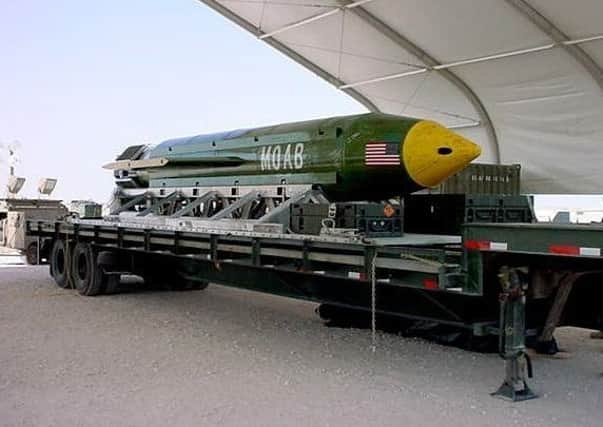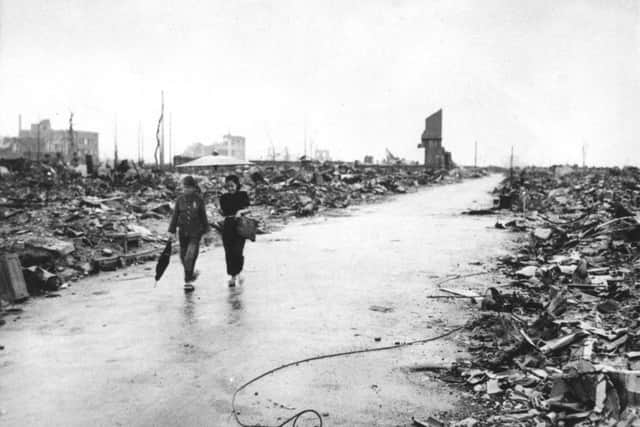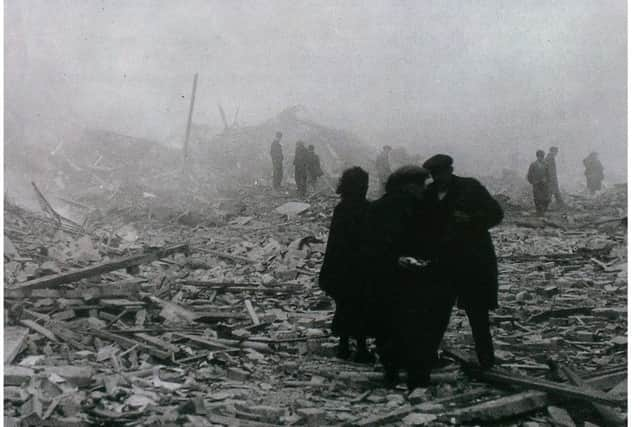Ben Lowry: Why the use of this huge non-nuclear US bomb fills me with foreboding


It is said that only Islamic State fighters were killed and no civilians, and that is welcome news.
It might be that the use of this device was appropriate on this occasion, but even if so it is a sombre day for mankind.
Advertisement
Hide AdAdvertisement
Hide AdI have no doubt about the validity of the conservative military doctrine that ‘peace flows from strength’.


Western liberal democracies, for all their faults, have created societies that no other civilisations have come close to matching, in their combination of prosperity and the rule of law and key rights such as expression and of democratic input.
If such democracies decline to put in place robust military defence capabilities, they put their very existences at risk.
America and to a lesser extent Britain do make that investment in defence.
Advertisement
Hide AdAdvertisement
Hide AdI have thought for many years that Germany has shown such comprehensive contrition and almost unprecedented (in any country that I can think of) soul searching and self criticism since World War Two, that it has easily proven how suited it is to significantly increasing its military capabilities and so helping to keep the world stable.


But for western democracies to be strong militarily is one thing.
There are other powers that do not share our values, not even close, and when they come to the fore (some entities, perhaps a century or two away, that we can barely conceive of now) then those people who think that the United States is a fundamentally malign superpower will be longing for its return at the helm of global affairs.
And I fear the sort of military technology such a nation or empire might have and how they will use it.
Advertisement
Hide AdAdvertisement
Hide AdThis is one reason I am concerned about the growing use of drones in warfare.


Imagine a future in which that technology is refined so that it can be easily applied by rogue states or perhaps even lunatic terror cells to send a missile from the other side of the world into your house. After all, we can now with ease zoom in on any place on earth.
The threat has been in my head for a long time but fully came home to me some years ago my aunt was visiting from America with a friend and colleague of hers.
The friend told me about the big old American house that she lives in to the west of Boston. Having been born in New England, I have a soft spot for those colonial-style homes, surrounded by trees, and so I was able to indulge the fantasy of living in one as she told me how she had ended up living in the property, having worked her way up the housing ladder at a time when prices were lower.
Advertisement
Hide AdAdvertisement
Hide AdOn my laptop using Google maps I zoomed in on the house from above, and then walked round it at street level, and pulled up details which showed the price history, showing that it had last sold at just the price she remembered, and revealing the taxes applicable on the property and so on.


It is terrifying to think of an age in which fanatics could use such information on the other side of the world to send a missile in on the home of someone that they wanted to kill, perhaps for a trivial reason.
While I have never had a moment’s hesitation in accepting that the Second World War was a just conflict, or about our deep debt of gratitude to the allies, it is chilling to think of the scale of civilian losses in civilian centres of power in Axis countries, such as a Dresden and Hiroshima and Nagasaki.
The horrendous near 1,000 deaths that Belfast sustained in a single night in April 1941, more than a quarter of the overall number of Troubles dead, was a minor event compared to the losses in those German and Japanese cities.
Advertisement
Hide AdAdvertisement
Hide AdI can only hope that no-one alive today will ever wake up one day to learn of a nuclear explosion going off in a large urban area somewhere.
September 11 2001 changed the world because it showed a willingness to inflict that level of civilian deaths. If the Twin Towers had been hit further down, so that no-one could escape, and an hour later, when they would have been more full, the death toll would perhaps have been 20,000 people.
Extremists who would aim to kill as many people as that would certainly use weapons of mass destruction to take out 100,000+ people if they could.
My big hope is that technology stays one step ahead of the madmen.
Advertisement
Hide AdAdvertisement
Hide AdLast year I was at Devesulu in Romania, where an American anti missile facility was completed, that was the fruition of Ronald Reagan’s once mocked ‘Star Wars’ project to shoot threatening missiles out of the sky.
We must live in hope, but never drop our guard against the fact that a tiny number of very wicked people would inflict harm on a apocalyptic scale if they could.
• Ben Lowry (@BenLowry2) is News Letter deputy editor